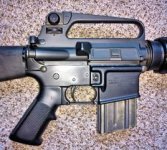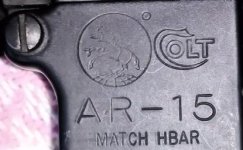Well to be fair the time the M16A1 and especially M16A2 came out, the guns were largely fixed. I will agree I wouldn't have much use for a first gen M16 repro, talk about a dud!
The
introduction of the M16 had a number of problems - more so than the M-16 having problems.
1) Remington used the wrong bullet
Stoner designed the cartridge to meet a 500 yard penetration requirement, and to accomplish it used a 55 gr bullet with a 7 caliber secant ogive and a 9 degree boat tail. The initial rifling twist specified by the US Army was 1-14, which was intended to optimize the wound ballistics caused by tumbling and fragmentation. However, it left this longer bullet only marginally stable and when Remington was tasked with producing the XM-193 round they noted the problem and substituted a shorter bullet. The US Army discovered the stability problem in spades in cold weather testing in Alaska and specified a 1-12 twist.
Thus, all the velocity and chamber pressure and propellent problems that followed probably could have been avoided if Remington had just told the US Army the bullet twist was too slow to start with. However, the shorter bullet became standard in the M193 ammunition. Unfortunately this shorter bullet with it's 5 caliber ogive had a much lower BC and shed velocity much faster. That meant it needed to be launched about 200 fps faster to meet the 500 yard penetration requirement (a steel pot, simulated by 10 gauge steel plate). Stoner stepped up and essentially said, "Hey stupid it's the bullet" and testing by the US Army confirmed this, but none the less they stayed with the shorter, blunter, "Type A" bullet for M193 production.
2) They screwed up the propellant.
The resulting need for more velocity led to increased chamber pressure and major problems in finding a propellant that would produce the required velocity, even within the increased maximum average pressure specification, and the propellent needed to be cheap and easy to produce.
The increased pressure and variation in propellent caused cyclic rate issues and the colonial ball powder eventually selected (WC844) had about 8 times more calcium carbonate than was actually needed to stabilize the powder and this caused problems with the M16's gas tube. Both these issues contributed to initial reliability problems. Colloidal ball powders were cheap, easy and quick to produce and could use surplus cannon powder left over from WWII. But the acids used in the process had to be neutralized, and they used way more then necessary just to stay on the conservative side - not considering the effects on the M16's direct impingement gas system.
3) The whiz kids in charge decided that it didn't need any cleaning in the field.
This may have been an honest misunderstanding or it may have been an effort to cut acquisition costs by not contracting for cleaning equipment - or both. The end result is that the initial batches of M16s underwent testing in combat with inadequate cleaning and maintenance in the field.
The propellent issues, cyclic rate issues and cleaning issues combined to create some serious reliability issues. All of those were eventually resolved, but the reputation stuck.
Ironically a generation later when folks were headed downrange to another war, there were those who advocated running the M16 and the M4 almost dry, on the theory that running them that way resulted in less dust being caught inside the rifle and would produce better reliability. Those folks had reliability problems and then of course blamed the rifle. They failed to consider that the "run it dry" logic was complete and total BS. The M16/M4 has laws run better when well lubricated. The general rule, "If it's shiny, oil it" works well on the M16/M4 series.
The one on the left looks just like the one I humped in Nam with out the scope.I wish I had one just like it.

I was issued an M16A1 just as the M16A2 was beginning to enter service. I had very low expectations as I my dad and several uncles had all served in WWII and were fans of the M1 and the later M-14. That was reinforced by older cousins who swore by the M-14 as well as by the bad press and bad reputation the M16 carried forward ever since those initial combat trials. Finally, I'd shot the M-14 in service rifle competition in college and I both liked it and greatly respected it's capabilities, particularly at long range.
However, I was pleasantly surprised to find the M16A1 to be very reliable and capable of accuracy in the 1.5-2.0 MOA range. It was very effective on torso sized targets out to 350 meters and the flat trajectory and the L shaped sight made it very fast and effective in engaging targets from 25 meters to 350 meters.
I also found it was very well balanced, easy to carry in the field and very agile in shorter range engagements. In short, I liked it a lot.
The M16A2 left me unimpressed. The heavier barrel profile in front of the hand guards, and the larger round hand guards probably made it harder for some moron to bend a barrel by using it to pry open crate (during my service I encountered a number of M16A1s that ran out of windage adjustment due to a bent barrel), but the heavy barrel and larger hand guards had detrimental effects on the handling traits. It lost the balance and feel of there A1, and the larger hand guards, while interchangeable and eliminating a part number, were not as comfortable to hold and did not help level the rifle when shooting off hand or from a "foxhole prone" position.
The A2 rear sight was nice, but I never saw a need to shoot past 350 meters in any reasonable scenario. More often than not the sight just got left on a battle sight zero that actually made it a bit slower compared to the M16A1 when it came to transitioning from 50-300 meter targets to 350 meter targets.
The 1-7 twist was also an unfortunate choice, as M855 was optimum in a 1-9 twist and the 1-7 was adopted solely to support M856 tracer rounds, that were seldom used. What it did do was prevent the use of M193 rounds, which in some ways were superior to the M855.








